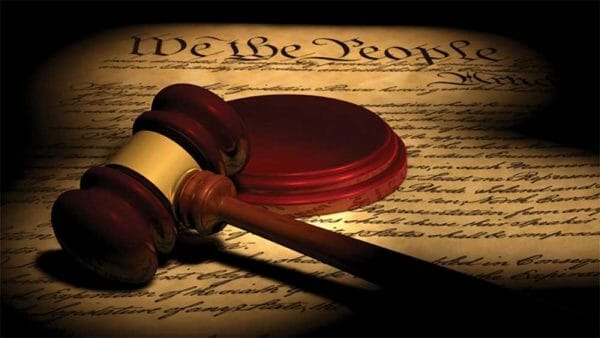
“We have never squarely addressed what types of weapons are ‘Arms’ protected by the Second Amendment,” Supreme Court Justice Clarence Thomas noted in his statement on the Court’s July 2 denial of petitions for writs of certiorari in HARREL v. RAOUL, a challenge to the State of Illinois’ so-called “assault weapons” ban. The procedural sidestepping means the edict will continue to be enforceable, a decision on a right denied will continue to be delayed, and American citizens will continue to be at risk of having their lives destroyed for daring to claim their right to keep and bear arms.
That’s the key word: Arms. And using the Court’s Bruen standard of history, text, and tradition, it’s impossible to see how any but gaslighting liars, and/or totalitarian fanatics, and/or the mentally defective could argue semiautomatic firearms are not arms, with the only proscription being that government “shall not” infringe.
What was the common understanding “back then”?
“Noah Webster (1758 – 1843), was a lexicographer and a language reformer,” MasonSoft Technology explains. “In 1806, Noah Webster published his first dictionary, A Compendious Dictionary of the English Language. Then in 1807 he began working on an even more comprehensive edition, and in 1828 this was published as An American Dictionary of the English Language.”
He lived through the time of the Revolution and the ratification of the Constitution. Here’s what how his authoritative dictionary defined that key word:
‘ARMS, noun plural [Latin arma.]
- Weapons of offense, or armor for defense and protection of the body.
- War; hostility.
Arms and the man I sing.
To be in arms to be in a state of hostility, or in a military life.
To arms is a phrase which denotes a taking arms for war or hostility; particularly, a summoning to war.
To take arms is to arm for attack or defense.
Bred to arms denotes that a person has been educated to the profession of a soldier.
- The ensigns armorial of a family; consisting of figures and colors borne in shields, banners, etc., as marks of dignity and distinction, and descending from father to son.
- In law, arms are any thing which a man takes in his hand in anger, to strike or assault another…
Fire arms are such as may be charged with powder, as cannon, muskets, mortars, etc.
A stand of arms consists of a musket, bayonet, cartridge-box and belt, with a sword. But for common soldiers a sword is not necessary…
It’s interesting to note that “or armor for defense and protection of the body” shows prohibitions like New York’s body armor ban with its standing army exemptions for the unconstitutional tyrannical abominations that they are.
And so much for Joe Biden’s demented assertion that when the Second Amendment was passed, “You couldn’t buy a cannon.”
Justice Thomas is correct in highlighting that “The AR-15 is a civilian, not military, weapon. No army in the world uses a service rifle that is only semiautomatic” (even ATF agreed that it was intended for the civilian market back when it was introduced). Where those who decry them as “weapons of war” all miss the point that those are exactly what the Framers intended for the citizenry to have.
As Continental Congress Delegate Tench Coxe asserted:
“Who are the militia? Are they not ourselves? Is it feared, then, that we shall turn our arms each man gainst his own bosom. Congress have no power to disarm the militia. Their swords, and every other terrible implement of the soldier, are the birthright of an American…. [T]he unlimited power of the sword is not in the hands of either the federal or state governments, but, where I trust in God it will ever remain, in the hands of the people.” (Tench Coxe, The Pennsylvania Gazette, Feb. 20, 1788.)
It wasn’t just Congress that had no power. Neither, in this case, does Illinois.
“No clause in the Constitution could by any rule of construction be conceived to give the Congress a power to disarm the people,” William Rawle warned in View of the Constitution (standard constitutional law text at Harvard until 1845 and at Dartmouth until 1860). “Such a flagitious attempt could only be made under a general pretense by a state legislature. But if in any pursuit of an inordinate power either should attempt it, this amendment may be appealed to as a restraint on both.”
“Second Amendment commas still causing controversy,” this correspondent noted in a June AmmoLand column, further exploring the effects of grammar on historic text and understanding. That prompted WarOnGuns Correspondent “Patrick F.” to send photographic evidence that many accepted documents following ratification found no disconnect in presenting the amendment with only one comma:
“I have attached a book titled, ‘Jefferson’s Manual’ which was printed by the authority, and the order, of the US Senate in 1828. The book is basically Robert’s Rule of Order of the day and was given to all members of the Senate and the House of Representatives for reference. Here, the 2nd has one comma. One must know that this is the correct version because the U.S. Senate of the day, only 39 years after the ratification of the Bill of Rights, had it printed, and everyone knew at the time that it must be printed correctly.”
Note an important synopsis on the index page that, in a rational world, would put an end to the false argument that prompted the need for the Heller case and the entire “the Second Amendment was only intended for the Militia” lie):
“Rights of the Citizen declared to be– to keep and bear arms.”
That was the crux of it, what was considered most important. Any argument that contradicts that by claiming prohibitions are about “gun safety” is an intentional deception. Citizen disarmament is about power. Anyone who says differently is a liar, a fool, or both.
The questions now are, will the Supreme Court ever acknowledge that truth, or will the November elections hand Democrats the power to reshape it with an apparatchik majority? And what are gun owners willing to do to prevent that from happening, or to respond to tyrannical decisions if they don’t?
About David Codrea:
David Codrea is the winner of multiple journalist awards for investigating/defending the RKBA and a long-time gun owner rights advocate who defiantly challenges the folly of citizen disarmament. He blogs at “The War on Guns: Notes from the Resistance,” is a regularly featured contributor to Firearms News, and posts on Twitter: @dcodrea and Facebook.

from https://ift.tt/C5qimxf
via IFTTT

No comments:
Post a Comment